Dear Reader, in this age of AI created content, please support with your goodwill someone who works harder to provide the human-made. Sign up at the top of the lefthand column or bottom of this page. You will receive my hand illustrated monthly newsletter RESTORE NATURE and access to the biodiversity garden design course as I write...and nothing else, I respect your time. I am also removing the advertizing as best I can as its become intrusive inappropriate and pays me nothing.
A brand new biodiversity project Casabio launched at Kirstenbosch
 The botanist Dave Gwynne-Evans, creator of Casabio The botanist Dave Gwynne-Evans, creator of Casabio |
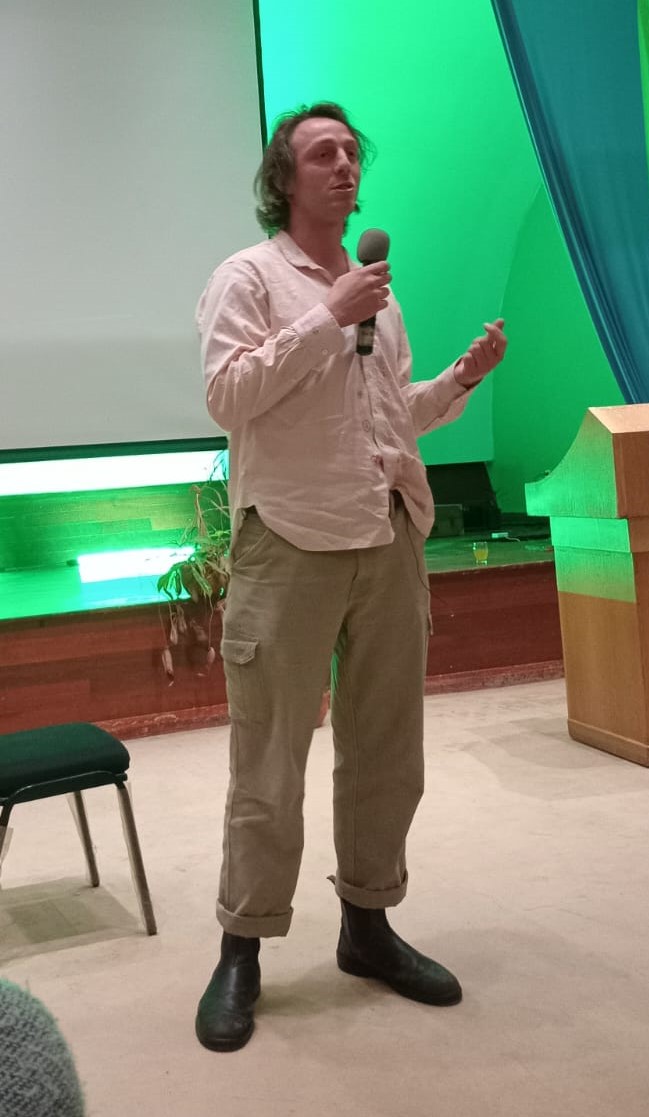 One of the team developing software for Casabio One of the team developing software for Casabio |
A new biodiversity supporting effort was launched on the 30th of August at Kirstenbosch by a Cape Town botanist and his multi-skilled team. It will be an open access online system. Amongst other functions it will be for digitally archiving data on African plants in one large central location. This gathering of information as well as the projects it will launch are aimed at pushing back against the staggering biodiversity loss in the Cape Town area. They've called it Casabio.
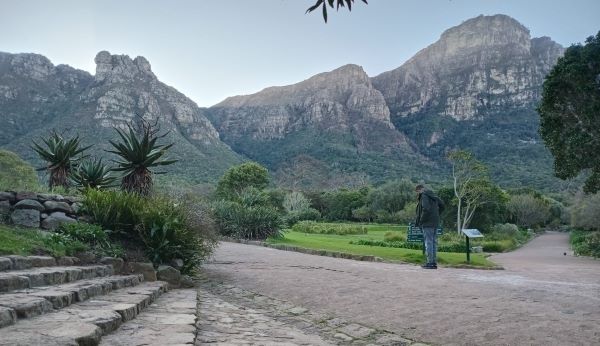 Our beautiful National Botanic Garden, here seen at dusk shortly before the launch of Casabio.
Our beautiful National Botanic Garden, here seen at dusk shortly before the launch of Casabio.Global and local background of biodiversity loss
As pointed out by Dave Gwynne-Evans and some other speakers at the event, we are in a serious crisis. Human beings are extracting far more resources from the earth than its biocapacity can carry. By 2050 we would need 3 earths to supply our needs for food and mined minerals. In the rush to supply human consumption many species of plants and animals are being driven into extinction.
The most marked jump in extinction rates of vertebrate animals like reptiles, frogs and birds is from about the year 1900 and is heading upwards in a hyperbolic curve. Insect numbers and diversity have also steadily declined since mid century.
Cape town is the most floristically biodiverse city in the world, and this diversity is under threat. South Africa has the second highest number of plant extinctions in the world. The Cape Flats, or the area of lowland between our mountains on which the city lies has the highest concentration of threatened plants per area of remaining vegetation in the world. Just under 1/3 of threatened fynbos plants occur in the city of Cape Town. Over 2300 plant species are to be found in Cape Town in an area of 2460km2, smaller than London. Of South Africas 21 threatened vegetation types, 11 lie within Cape Town's boundaries. For its size Cape Town's floral diversity is rivalled nowhere on earth !
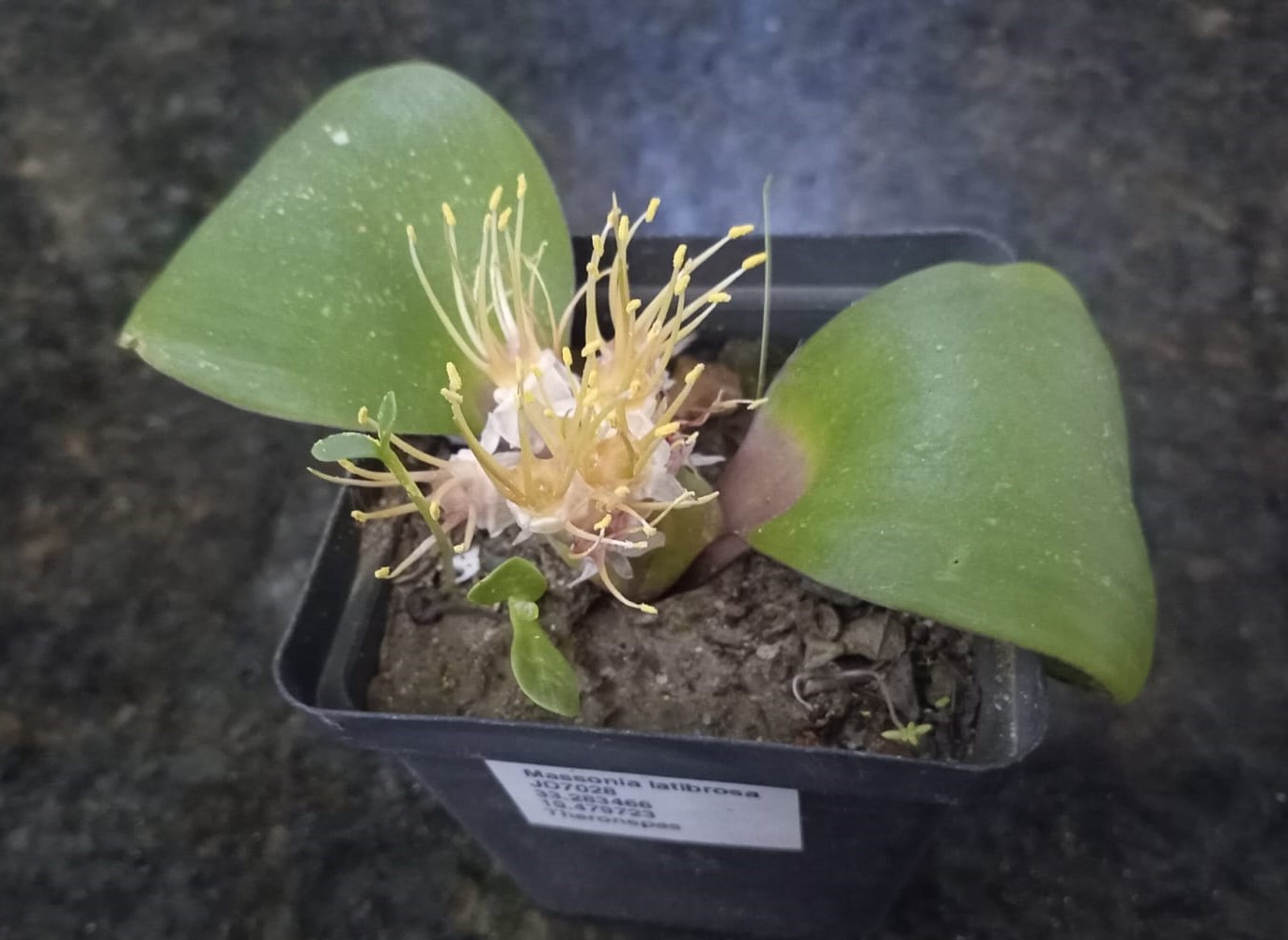 Massonia latebrosa, one of the plants exhibited at the launch.
Massonia latebrosa, one of the plants exhibited at the launch.Some impediments to preserving our biodiversity
FUNDING
The funding for research on botany and biology is inadequate compared to that of other sciences like physics and astronomy. For example the amount needed for establishing the citizen scientist platform iNat was less than 0.2% of the annual cost of running a large Hadron collidor. While it is clear we stand before a man made catastrophe concerning tangible living entities and their biodiversity here on earth, the existence of theoretically conjectured entities like subatomic particles and very distant stars have a very much larger priority.
IDENTIFICATION
Correct identification is another barrier. We do not know what many species of plants look like and they are incorrectly identified. A sizable number are not featured in any books on plants, and many of the invertebrates have not even been recorded.
LOSS OF HABITAT AND THEFT
Loss of habitat is perhaps the worst threat to biodiversity. From the destructive sand mining on the West Coast to the bad management of road and rail reserves, agriculture, other types of mining and the spread of alien vegetation and of human habitation, there are many ways habitat is lost. Climate change is another, as it affects suitable rainfall patterns and temperatures to which our plants are very sensitive. Poaching and smuggling of plants is an enormous business.
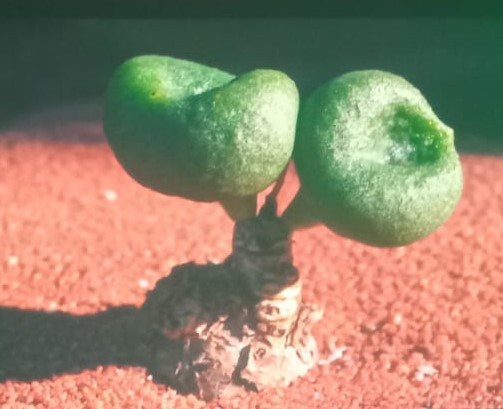 Tylecodon opelii Tylecodon opelii |
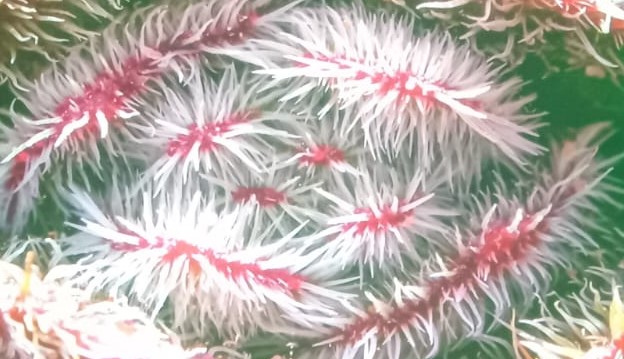 Crassula tomentosa Crassula tomentosa |
Rare succulents like these are often stolen from the wild. The original photographs were by Adam Harrower, but have lost detail between the slideshow and my cell phone camera
Some developments in botanical recording
The foundation of botanical science is recording plants. Kew gardens has taken in 7.5 million specimens in 150 years, that is at a rate of about 50 thousand a year. In the meantime technology has moved on and citizen science has gone mainstream. The first generation of identification apps such as iSpot recorded 500 thousand observations between 2012 and 2015, or about 166 thousand a year, three times the annual collection of specimens at Kew. When iNaturalist was launched it was widely adopted by South Africans, but perhaps its time we had our 'own' observation platform, being such a special case in the global context. Between 2008 and 2020 50 million observations were logged on iNat, approximately 4.1 million a year, heading for 100 times the rate of recording at Kew, and from 2020 to 2024 there were 162 million recordings, or 50 million per annum, about a thousand times the rate of recording at Kew.
This kind of power driven by citizen scientists is what David envisions for Casabio. He hopes that the data will help record loss of biodiversity and habitat and help people rally against ongoing development by providing a picture which goes beyond the limitations of the humanly observable.
We humans are blind to most biodiversity loss because of our life span. Each generation starts with their given environment and cannot experience or know of previous losses directly. In every generation more biodiversity and habitat is eroded.
What exactly will Casabio offer ?
David Gwynne-Evans spoke on some of the services, projects and archiving that would be encompassed by the Casabio system. The online platform with its system of apps will bring together a multiplicity of botany related resources. If artificial intelligence is processing all this data it will be possible to get a more full picture of biodiversity loss. This could point to the best levers for targeted action.
Here are some of the projects:
OVERCOMING IMPEDIMENTS TO ACCURATE IDENTIFICATION
- Digitized literature. All South African plant books will be scanned in to establish how many plants are known. There are about 22 thousand species in South Africa, of which about 10 thousand are represented by books and 12 thousand are undocumented.
- Etymologies of scientific names, that is what the Latin binomials actually mean. It helps with learning. The etymology of names in over 50% of African plant species has been made available thanks to Hugh Clark and Eugene Moll.
- Digitized herbaria. Using high resolution digital cameras, every herbarium specimen will be photographed. This will mean we know exactly what species have herbarium specimens.
PROMOTING PROPER PROTECTION OF OUR ROAD AND RAIL RESERVES
South Africa's road and rail reserves comprise the 13th longest network in the world.
There are 750 000 km of roads alone. With a reserved area 10m wide on each side of the road, this is 15 000 square km of reserve traversing all of South Africa's habitats, running through all altitudes, weather patterns and soils. To contextualize this vast space, the Kruger National Park is 20 000 square km in area. In Europe road reserves contain an average of 40% of each country's species. With 22 thousand species in SA the road reserves alone should contain 8800 species. It is promising indeed. Greg Nicolson has recorded 640 species in a mere 700km of road reserves. Of these 63 were red listed. Clive McDowell has attempted to conserve a road verge on the M3. In a small strip on the slope of Wynberg hill he has recorded 80 species.
Casabio's Project Satrn will have QR codes mounted on poles beside our national roads to facilitate citizen science records. The QR code at one end will be scanned, then the citizen scientist will document everything they see, plant and animal, and then scan the QR code at the other end, on the next pole. This will help assess the state of road reserves and assessment of improvement or degradation so that the degraders can be held accountable.
SPECIAL PERMITS
Some of the permit granting authorities make it very difficult for botanists to do their job. They are often hindered by people when trying to work, yet the permits are granted by the very powers who are brush cutting our road verges and damaging biodiversity. David wants to create a quick permiting system for road verges to make sure that potential records are not lost.
FILTERED LOCATION DATA TO PREVENT POACHING
Poaching is such a serious problem that all observation localities on the Casabio identification platform will be obfuscated for the public and only accessible for research. We can't predict beforehand what will be poached, and iNat has promoted rather than managed to prevent poaching in South Africa because its system is too transparent. As David says, we Africans must do it ourselves.
THE CASABIO BOT BOT
To make up for the lack of necessary recording, robots will be programmed to make plant records and work long hours in conditions where human strength fails.
TRAIN CAMERAS
Cameras on the exterior of trains will tirelessly record the state of the rail reserves and their surrounding countryside to monitor landscape degradation, temperature change and the like.
BIOSNAP SMART PHONE APP
In development and already in use on the platform for citizen science records is a smartphone app for doing observations and identification.
CSIR CHPC
The South African Council for Scientific and Industrial Research's will host Casabio's data at its Centre for High Performance Computing. This will enable high speed processing and a cluster using machine learning.
Some botanical education at the launch
Casabio stands on the three pillars of conservation, education and research. Here some more parts of the event which contribute to these.
A new species of olive discovered by David was on display (there are only 20 olive species).
Local activists and academics were given awards for their contribution to biodiversity preservation.
There was a slide show on the weird and wonderful succulents of the Tankwa Karoo by Adam Harrower, senior botanical horticulturist at Kirstenbosch. Unfortunately information on the location of many of these plants will have to be concealed from the public as they are subject to astronomical levels of theft by plant smugglers and for many of them their levels of endemism could make one hour of collection spell their extinction. Its a lesson to the most ardent collectors to make sure their plant purchases are legitimate.
 A bee visiting the spectacular Erica verticilliata, which was nearly lost. The photograph is from Dalton Gibbs' slide show.
A bee visiting the spectacular Erica verticilliata, which was nearly lost. The photograph is from Dalton Gibbs' slide show.A famous reintroduction project
The process and labour behind the reintroduction of a plant extinct in the wild Erica verticilliata was most interestingly explained by Dalton Gibbs the City of Cape Town's expert on the restoration of urban conservation areas. The plant was driven to extinction in the wild by agriculture, alien vegetation, urbanization, the drainage of seasonal wetlands and flower picking as it is one of the few summer flowering Ericas.
In 1988 Deon Kotze from Kirstenbosch finds an old plant in Protea Park Pretoria. 20 plants are laid out from ridge to wetland bottom in Cape Town setting and 1 plant survives.
In November 2001 the horticultural garden Vienna supply cuttings of a plant taken into cultivation in 1786-1799.
In 2001 100 plants of the Adonis clone from Kirstenbosch were planted out at Rondevlei. Adonis Adonis, a seniour foreman at Kirstenbosch discovered two different cultivars of the plant growing in the braille trail.
In April 2003 several flower heads produced seed.
In 2005 Victoria Wilman germinated 300 seedlings. At Rondevlei 150 plants of the Pretoria, Kirstenbosch and Vienna clones and home grown plants were planted out
In 2013 came a test by fire. Since 3 generations are needed for a species to be downgraded to be deemed no longer 'extinct in the wild' time will tell. Mr Able Scout born in Grassy Park in 1923 confirmed a site where the Erica used to grow
Kirstenbosch now has 8 cultivars of the species which can be viewed at this url https://pza.sanbi.org/erica-verticillata. Including the origins above there are three more which came from English collections at Tresco Abbey on the Isles of Scilly, Dr Violet Gray's collection and Kew gardens. A fourth cultivar was acquired from a nursery in Monterey California.
We have learned that it is a seasonal wetland ecotone species, associated with the Restio species Elegia tectorum. It may have been part of a red and pink flowering guild on the Cape Flats. It is heavily dependent on symbiotic micorrhizal fungi to help it survive dry summers. It is pollinated by the southern double collared sunbird and is visited by minute ghost frogs, bumble bees, bees, wasps, hawk moths and beetles.
The bumble bees are not such a good thing. They destroy flowers by nectar robbing, Their population may be out of balance and exceptionally high because of the wood of alien vegetation providing nesting space.
Let us celebrate this much needed innovation !
On the subject of plant insect relationships I've noticed a shortfall of information when compared to North American resources on plants. The cause seems to be that they have much more vast citizen science participation and far fewer plants, more money in the game and a much higher botanist to plant ratio. We do have the most floristically diverse region of the world, so this lack seems doubly unfortunate. Till now. Casabio should help towards us having more context appropriate resources.
As said, overall the project is aimed at supporting the conservation of African floristic biodiversity. I'm personally very happy about this development as it is a project that was waiting to happen. It is logical and necessary and extremely beneficial.
The idea was incubated and developed by David Gwynne-Evans over many years until everything lined up and it could be actualized. I am glad he and his collaborators, many who volunteer their time, are doing it. As one speaker said, David is a maverick, and it took a maverick to realize something so large in its scope, with the potential to solve so many problems in biodiverstiy conservation in South Africa.
Greenidiom home page for links to many topics on natural gardening
Restore Nature Newsletter sign up page
Restore Nature Newsletter
I've been writing for four years now and I would love to hear from you
Please let me know if you have any questions, comments or stories to share on gardening, permaculture, regenerative agriculture, food forests, natural gardening, do nothing gardening, observations about pests and diseases, foraging, dealing with and using weeds constructively, composting and going offgrid.
Your second block of text...
SEARCH
Order the Kindle E-book for the SPECIAL PRICE of only
Prices valid till 30.09.2023
Recent Articles
-
garden for life is a blog about saving the earth one garden at a time
Apr 18, 25 01:18 PM
The garden for life blog has short articles on gardening for biodiversity with native plants and regenerating soil for climate amelioration and nutritious food -
Cape Flats Sand Fynbos, Cape Town's most endangered native vegetation!
Apr 18, 25 10:36 AM
Cape Flats Sand Fynbos, a vegetation type found in the super diverse Cape Fynbos region is threatened by Cape Town's urban development and invasive alien plants -
Geography Research Task
Jan 31, 25 11:37 PM
To whom it may concern My name is Tanyaradzwa Madziwa and I am a matric student at Springfield Convent School. As part of our geography syllabus for this
"How to start a profitable worm business on a shoestring budget
Order a printed copy from "Amazon" at the SPECIAL PRICE of only
or a digital version from the "Kindle" store at the SPECIAL PRICE of only
Prices valid till 30.09.2023







